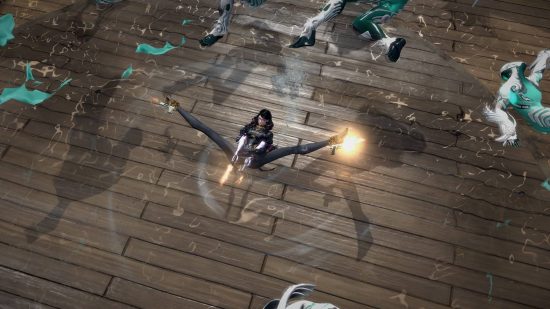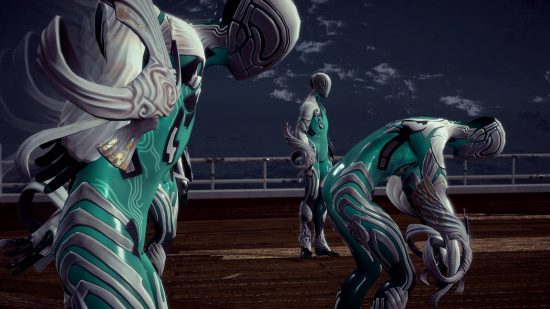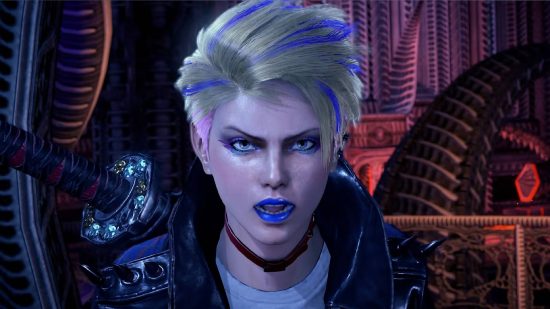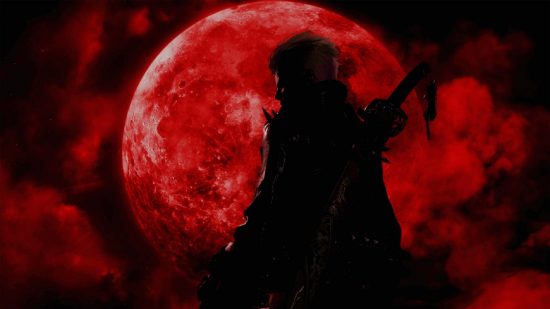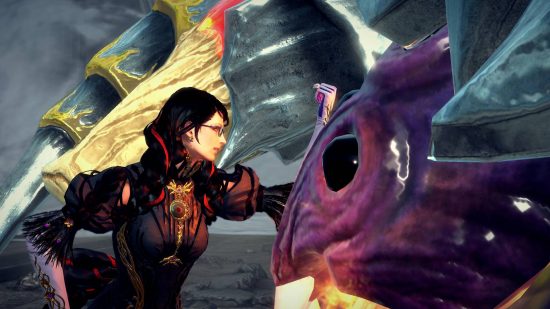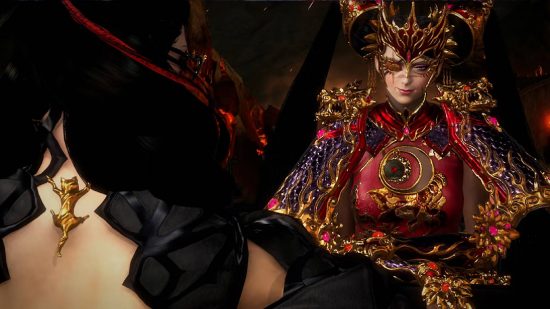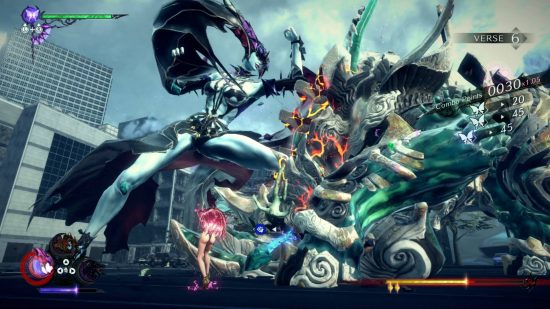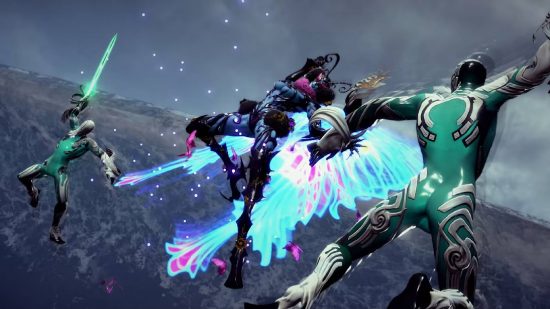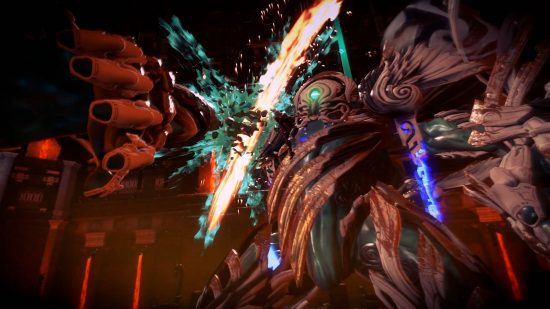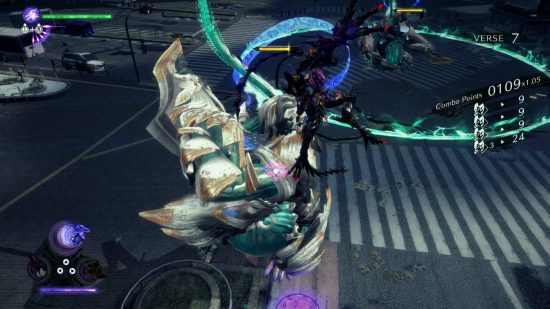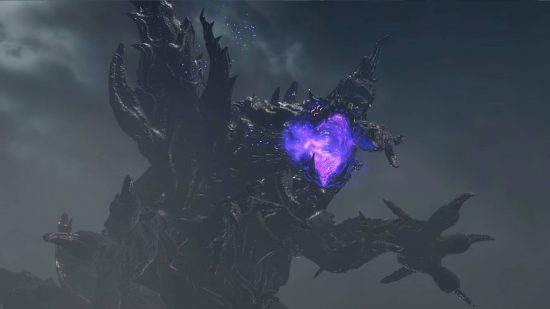Since picking up a second-hand copy of Viewtiful Joe (please bring those games to modern platforms) for my Gamecube, I’ve been enamoured by the Platinum team, whether it’s at Capcom or Clover, or wherever else Hideki Kamiya et al have produced. After Devil May Cry and its stellar action, Bayonetta somehow pushes the creative capabilities of Kamiya and Platinum even further, a game dripping in excess but so simple in its satisfying game feel.
Personally, I think Bayonetta 2 is a perfect action game. While Yusuke Hashimoto (Resident Evil (2022), Resident Evil 4) took the reigns, it takes all the charm, wit, and profanity that set Bayonetta apart, while pushing the action further. So now, we’re at the third in the trilogy, and Astral Chain’s Yusuke Miyata is now at the director’s helm, and for anyone who has played that title, it really feels like it, in all the best ways.
For the third entry, the umbra witch now sports another (her best) haircut, and you can ready yourself for even more over-the-top action, cheesy dialogue, and all the maximalist design we’ve come to expect from a new crowd of disgusting abominations. While angels and demons have taken up most of Bayonetta’s rogues gallery, this time a nefarious collective known as the homunculus is here to threaten everything Bayonetta knows.
I won’t get into many story elements in my review, as there are spoilers to be spoiled. Safe to say this, while each Bayonetta game is an exercise in escalation, Bayonetta 3 takes things even further. I was genuinely unsure of where the series could even go, but trust me, from the first few chapters I was absolutely astonished at the way this entry has gone, and it’s so perfectly ridiculous and somehow still presented with an earnest grandiosity that makes it all work.
You’re quickly introduced to Viola as well, who is somewhat key to the story and everything it brings, and while her bratty ‘punk’ persona is a little on the nose, I actually warmed to her quickly. You control Viola in some missions, and she has a slightly different moveset that swaps Bayonetta’s dodge for a parry, and her guns for throwing darts, meaning your timing is ever so slightly different when countering enemies. Viola feels fantastic though, and her energetic fighting style matches her personality, even if it takes some getting used to. She feels more active to Bayonetta’s reactive abilities, and I never feel annoyed taking a break from my main bae, Bayo.
Speaking of fighting, those of you returning may wonder what’s different about Bayonetta 3, and if you’re lucky enough to have played Astral Chain, then you should already have a good idea. The core of Bayonetta 3 is still an utterly sublime, and fluid combo-based action game, marrying close-range moves with her pistols to chain attacks while using her dodge to activate witch-time and get in a few extra licks. The kicker is that while previously Bayonetta’s demons were kept for specific occasions, now they’re integral to every second of combat, and you can summon them much like Astral Chain’s Legion using the Demon Slave technique.
The returning scaly titan Gomorrah and many others are summonable at any time, with a meter denoting how much magic you have left to continue using them. These gigantic partners take up a lot of space and are perfect for clearing out large enemies, and you can instantly flit between them to utilise different attacks. But where it gets even more fun, is where they add to the chain attacks. Bayonetta’s dodge is integral to her move set, with witch-time a defining gameplay element that’s satisfying and spectacular. Enemies (most of the time) telegraph their moves, so it’s up to you to read the action and deploy the dodge when it works best.
On top of Bayonetta’s library of tricks and treats, devastating combos and ridiculous attacks, now you can read for specific moments in the chain of attacks to summon the Demon Slaves, adding particularly glorious flashes of kaiju action to the already satisfying activities. You start with Gomorrah and Madame Butterfly, who both present fairly different move pools, and you can even unlock new combos and attacks for each Demon Slave you find. That’s right you unlock more (so many more) as you progress, and an early one is the enormous spider demon known as Phantasmaraneae.
Honestly, with the addition of Viola and the Demon Slave techniques, as well as the rock-solid foundation of Bayonetta’s regular attacks, there has never been so much… Bayonetta, in a good way. It feels like every logical corner of the game that could have been expanded has been, and it’s all been done extremely well. Viola even has her own Demon Slave in Cheshire, a grinning cat that really spells out the Alice in Wonderland influence but is still extremely loveable and controls like a beast, so missions played as her don’t miss out on the monster mash.
From start to climactic finish (oh god, what a finish), Bayonetta 3 never stops throwing new things at you that feel like a natural expansion of the existing moveset. As well as the occasional kaiju set piece where you control a gigantic demon, taking down the humongous homunculi and other throngs of threatening invaders, there’s a constant influx of new weapons which come with new traversal techniques, new Demon Slaves, and even new outfits and colourways. Sadly, there are no Nintendo outfits this time, but I think you will be very satisfied with what we do have instead.
Meanwhile, if you think the Demon Slave techniques are just a mindless button mash on top of regular combos, think again. They’re consistently inventive expansions of Bayonetta that get increasingly ridiculous and impressive. Early on Bayonetta unlocks a Demon Slave technique called Wattrain Gouon, a demon train that you must lay the tracks for, lay out bomb placement, and then watch the train tear across your placed tracks and hit any enemies it catches on along the way.
The matching weapon known as Dead End Express transforms Bayonetta into a terrifying Thomas the Tank engine homage that’s part lady and part locomotive, swinging around gigantic train carriages in either arm for devastating attacks. Later on, there’s also Baal, an enormous singing toad that utilises its voice to call down poisonous rain, if you can avoid attacks long enough to pull off the long raindance technique.
All of the Demon Slaves come with an accompanying weapon, each upgradable with new combinations, there’s barely a minute in the game where you aren’t having fun with a new Demon Slave, weapon set, or an unlocked combo attack. They’re not all as fun to use as one another, particularly the animal traversal techniques that comes along with them. I mainly use the Phantasmaraneae spider transformation as it makes crawling on walls to reach unlockables much easier. But, almost all of them are a blast to try out, and I’m certain you’ll come up with wildly different combinations of weapons, demon slaves, and accessories to assemble the perfect build as you grind out the pure platinum medals.
Thanks to those aforementioned medals and a few extra tweaks, Bayonetta 3 is possibly the most replayable entry in the franchise. For the unfamiliar, you’re graded after every chapter on your time, your combo, and damage taken. So if you want that pure platinum, you had better practice your dodge and the witch time abilities, as well as chaining combos together with the guns, and the demon slave techniques, all on top of regular attacks and combination moves. It’s a medley of mayhem, but it feels incredible when you can keep that combo meter climbing and unleash pure hell on your foes.
Alongside the medals, there are three collectable creatures in each level, a cat that runs away, a crow that flies away, and a toad that’s hidden somewhere despicably discreet, but lets out a faint croak when you’re nearby. Catching them all is a real challenge, and you’re rewarded for catching them with another version of the level known as a Remnant Chapter, using the same map but posing unique challenges like a rush through a set of enemies or a giant collectable mission. It’s a smart way to reuse assets and adds a lot of fun for those out to 100% the title.
This is on top of the Viola missions, which play similarly to Bayonetta’s but with Viola’s more aggressive playstyle, and then, there are the Jeanne side missions. 2D sidescrolling action through a Metal Gear Solid-like facility that still uses witch-time abilities and action while Jeanne must search for a character essential to the story. These breaks from regular combat are a lot of fun, thanks to the addition of some ridiculous weapons, and the fact Jeanne can even hide in vents and drop behind enemies to pull off sneak assassination attacks. There’s even more down the line, but safe to say, Bayonetta fans are getting bang for their buck in this entry.
I do have a couple of gripes, and one is that with so much added to the action, it can be easy to lose yourself in it all, and the camera doesn’t always find the best place to perch. Luckily, dodgeable attacks are normally telegraphed with a bright green streak across the screen, and moments to add Demon Slave techniques to your combo are telegraphed with a bright purple one. You’ll never miss out on a combo because of the camera, and it’s easily adjustable with the second analogue stick, but try finding the time to do that when you’re surrounded by ten enemies and are desperate to earn that platinum medal.
Secondly, while Bayonetta is an action game first, you still spend a lot of time exploring levels, combing for collectables, and discovering secrets tucked away in every corner. This is often how you find additional moments of combat (great, love all of that), but there’s also the odd platforming challenge whether it includes moving, floating platforms, or now turning back time to assemble pieces of the environment in just the right place as to reach a new area.
Most of the time, this is fine. However, Bayonetta doesn’t feel great as a platforming protagonist, because she’s designed to move quickly and almost weightlessly, there isn’t the weight and momentum you would expect. For easy platforming this is fine, but even with a robust move set of transformations designed to help you scale buildings or fly around, the occasional platforming challenge just doesn’t quite gel with Bayonetta’s feel. Instead, making what should be a fun challenge, turns into a fight with a protagonist a little too quick and nimble for her own good. It’s a small complaint that doesn’t get in the way of the action, but I like to get everything in a level the first time around, so I find myself frustrated with a lot of these platforming challenges.
For a final gripe, I want to touch on the homunculi as enemies. These blue-green humanoid figures don’t have the same terrifying presence as some of the gruesome demons from previous games. They do quickly escalate in size and grossness though, and I absolutely adore some of the more Lovecraftian designs later on. Within the story, they make perfect sense, and the slow reveal of their purpose and driving forces are incredible.
I just wish the basic enemies were a little more thrilling as you’ll be seeing a lot of them. It’s a really minor nitpick though, as there are so many different baddies to fight, and importantly, exploring the levels rewards you with fights with angels and demons that have been pulled into the main story for different reasons.
The whole story of Bayonetta 3 is the best in the trilogy, with some really unexpected turns and an ending which I regret to inform actually brought me to tears. It’s no surprise that a Bayonetta story goes above and beyond expectations, but I think you’ll be surprised by just how far this universe is pushed. The opening chapter is an incredible and devastating reminder of this, subverting expectations and laying out plainly to every player that this story, and this threat, are like nothing that’s come before.
The visuals elevate the narrative as well, as PlatinumGames clearly know the Switch inside and out by now. The story quickly moves between many wildly different locations, and each one is unique but presented with a charming visual style and impressive graphical fidelity. The wizardry PlatinumGames used on Astral Chain is on full display again here, and whether playing in docked or handheld, the character models and levels are shown with a crispness that only a game like Monster Hunter Rise really compares with.
I know some of the 60FPS boffins want to know if the game is locked there constantly, and as far as I can tell, it is where it counts. When playing with just Bayonetta in combat or exploring levels, the game runs smooth and looks amazing while doing so. Occasionally when you enter bigger set pieces that have you jumping between the crumbling ruins of entire buildings on the back of an enormous hell beast, the framerate drops down to accommodate the action, but in these moments you don’t need the pinpoint accuracy of regular combat. These moments are more ‘rollercoaster’ breaks, where the spectacle is front and centre, and the occasional button press is all you need.
Lastly, Jennifer Hale does a fantastic job picking up the Bayonetta baton, and while Hellena Taylor’s contribution to the Bayonetta franchise will always be beloved, the wicked witch is in safe hands. She feels every bit as authoritative and somehow still mischievous in each moment, and the more touching elements of the story are delivered with the gravitas and earnestness needed, despite how ridiculous the story might be. Similarly, Anna Brisbin’s Viola is an infectiously energetic character that I warmed to very quickly, and Yuri Lowenthal turns in a great performance as Luka, who gets much more time to shine.
I completed Bayonetta 3 well over a week ago, and have spent the last few days replaying missions, finding every collectable, unlocking every accessory, trying them out, and playing around with different weapon combinations to grind out the pure platinum medals. Importantly, I wouldn’t be doing this all over again if it wasn’t ridiculous fun. Bayonetta 3 builds off rock-solid foundations and somehow throws everything and the kitchen sink at the formula, but it all works.
The Demon Slave techniques feel like they’ve been here all along, and Bayonetta’s deadly dance and lightning-quick moves feel as sharp and satisfying as ever. The real magic comes in hot-swapping between them when that purple light flashes, and suddenly controlling a lumbering titan that lays waste to everything on screen. It’s a delicate balance, and they do just enough damage to feel essential to use, but not so much to make Bayonetta feel redundant. The system works, and it’s dizzyingly joyful to unleash attacks from either side of this partnership.
Bayonetta 3 is a love letter to every aspect of this thrilling trilogy, and PlatinumGames stunning library of work to date. Bayonetta has never been so… Bayonetta, and PlatinumGames has never been better. Each chapter is stuffed with things to find and do, and every corner of the game expanded with Viola, Jeanne, Demon Slaves, and much more I won’t spoil. PlatinumGames has crafted an action masterpiece and a rip-roaring rollercoaster storyline, building on everything that came before and improving it, closing out one of the best trilogies in video games with a bombastic Bayonetta-loving bang. I can’t wait to see where it goes next…
Bayonetta 3 review
A smart expansion of incredible action foundations, PlatinumGames’ latest entry delivers a wild story and defies expectations while presenting heartwarming themes at its core. Bayonetta 3 is an action masterpiece, offering a veritable feast for fans of the Umbra witch and closing out the trilogy with the biggest and best entry yet.
